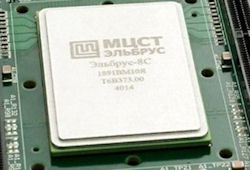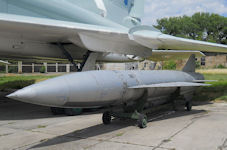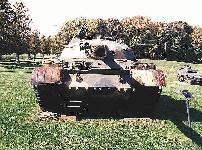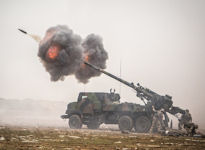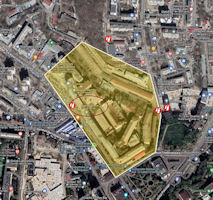Russo-Ukraine War - June 2022
| Su | M | Tu | W | Th | F | Sa |
|---|---|---|---|---|---|---|
| 1 | 2 | 3 | 4 | |||
| 5 | 6 | 7 | 8 | 9 | 10 | 11 |
| 12 | 13 | 14 | 15 | 16 | 17 | 18 |
| 19 | 20 | 21 | 22 | 23 | 24 | 25 |
| 26 | 27 | 28 | 29 | 30 |
On 24 February 2022, Ukraine was suddenly and deliberately attacked by land, naval and air forces of Russia, igniting the largest European war since the Great Patriotic War. The military buildup in preceeding months makes it obvious that the unprovoked and dastardly Russian attack was deliberately planned long in advance. During the intervening time, the Russian government had deliberately sought to deceive the world by false statements and expressions of hope for continued peace.
"To initiate a war of aggression... is not only an international crime; it is the supreme international crime differing only from other war crimes in that it contains within itself the accumulated evil of the whole." [Judgment of the International Military Tribunal]
Russian President Vladimir Putin announced a "special military operation" in Ukraine in response to the appeal of the leaders of the "Donbass republics" for help. That attack is a blatant violation of the territorial integrity, sovereignty and independence of Ukraine. Putin stressed that Moscow's goal is the demilitarization and denazification of the country.
The war in Ukraine has become “a war of attrition,” and Western nations must prepare for "the long haul," NATO chief Jens Stoltenberg warned on 02 June 2022 following talks with US President Joe Biden. “Wars are by nature unpredictable and therefore we just have to be prepared for the long haul," Stoltenberg told reporters after meeting Biden at the White House.
The main forces of Russia's attacking forces are now concentrated in Luhansk and Donetsk regions. After the defeat near Kiev, Russia announced new goals of "special operations in Ukraine": to establish full control over Donbass and southern Ukraine to ensure a land corridor to annexed Crimea, gain access to Transnistria, and "impact on vital objects of the Ukrainian economy." According to military analysts, the Kremlin has moved from parallel to consistent tasks, and if it manages to move forward in the Donbass, it will take on other areas. That is why the outcome of the battle for Donbass is so important.
Russia’s assault into northern Ukraine ended in a costly failure. Russian forces failed to achieve their initial objectives to seize Kyiv and Ukrainian centres of government. Staunch Ukrainian resistance and the failure to secure Hostomel airfield in the first 24 hours led to Russian offensive operations being repulsed. Russia failed to implement its own principles of war. With the limited combat readiness of many units, it spread its forces too thinly without enough support from artillery and combat aircraft. Above all, it was based on wildly optimistic assessments about the welcome Russian troops would receive in Ukraine. Following the failure of the initial plan, through false planning assumptions and poor tactical execution, Russia adapted its operational design to focus on the Donbas. Russia has now adopted a “strategy of attrition” and is achieving slow and costly gains in the Donbas.
In its fourth month, the war’s dynamic changed. Russia consolidated its forces, keeping its best troops for the operation in the Donbas while continuing to hold its positions elsewhere using reservists equipped with older tanks like the T-62. As Ukrainian air defence units pull back from the Severodonetsk pocket to avoid encirclement, Russia’s air force can now operate more safely, being threatened by shoulder-launched weapons which are only effective against low-flying aircraft. This has allowed the Russian air force to support the accompanying ground advance, pummeling the two besieged cities, already devastated by artillery and missile attacks.
Both sides now use drones effectively, the sight and sound of one usually a prelude to an artillery attack that in the flat terrain can have devastating consequences for units with relatively few places to hide. Artillery is the prime weapon of choice as duels are fought between the two armies. Foreign weapons systems, howitzers, tanks and multiple rocket launchers supplied to Ukraine by the West, are making themselves felt but also bringing their own problems.
Sustained combat takes a toll not just on the people who fight but also on the equipment used. The barrels on artillery pieces get worn out after several thousand rounds, lose their accuracy and need to be replaced. The tracks on armoured vehicles need regular maintenance. Damaged vehicles can be fixed but this takes time and manpower. Russia’s troops have to deal with poor maintenance but Ukraine’s maintenance and repair crews now struggle to fix a variety of unfamiliar foreign systems for which there are few spare parts. Damaged tanks, vehicles and artillery have to be redrawn from vital sectors while they are being repaired by the few Ukrainian staff that are able to fix and turn them back into effective weapons.
Ukraine as an adversary turned out to be much stronger than it seemed for many on the eve of the offensive. Within a couple of weeks it was possible to occupy the territories of several regions without serious fighting. However, there was no collapse of the Ukrainian state, troop control was maintained, mobilization was carried out, and supplies were secured. Seeing that Ukraine was holding on and could fight, the West finally decided to deliver extensive military supplies.
Russia concentrated its forces in the east for a large-scale artillery fight reminiscent of World War II battles. Experts say Moscow hopes to take advantage of having the upper hand in terms of manpower and weapons, something visible in its nonstop bombardments of Ukrainian forces in the Donbas. The West is taking steps to arm Ukraine for the new reality of the war before it is too late.
By early June Russia had about 110 battalion tactical groups (BTGs) in Ukraine, according to the United States. Each group could have six to eight artillery pieces such as howitzers or rocket launchers, an estimate that would put the total as high as 900, with the majority concentrated in the Donbas. The Russian 2S7 203-mm Self-Propelled Gun has a maximum range of 37.5 km with conventional shells and extended range of 47.5 km with active rocket. The 2S19 MSTA-S 152-mm Self-Propelled Howitzer has a maximum range of 29 km with conventional shells and extended range of 41 km with active rocket.
Tectonic shifts had taken place in the Russian-occupied Kherson and Zaporozhye regions: the creation of fully fledged civil-military administrations, the switch to ruble payments, the connection of Russian television and the internet, and the switch to SIM cards of Russian operators. Russian car number plates are being issued, symbols of Ukrainian statehood are being dismantled, and the procedure for issuing Russian passports has been adopted. All indications are that Russia is serious about the territory and intends to stay there for a long time.
The conflict remains localized and peripheral for everyone except Ukraine. Russia is fighting with a peacetime army, essentially an expeditionary corps at maximum capacity, while the West, although supplying Kiev’s forces on an unprecedented scale, is not yet supplying the latest and most expensive weapons and is not intervening with its own troops.
Objectives have changed. The closing of the Severdonetsk pocket aside, the focus is now on transport nodes like rail junctions vital in a conflict where soldiers, military vehicles and vital supplies have to move large distances and arrive fresh to fight. Trains are able to move hundreds of troops and thousands of tonnes at any one time, which is very useful to Russia’s military as it is able to sustain its advance towards its objectives, albeit at a slow and costly pace.
Russia still has not suppressed Ukraine’s air force but it is not trying to. It is making slow gains and steady moves, using troops that are increasingly battle-hardened and keeping casualties relatively low when compared with its disastrously clumsy moves at the beginning of the invasion. The air force now works more efficiently supporting infantry and armored units.
Belief in a speedy victory has disappeared from Ukrainian society. Alexey Arestovich, a top adviser to the office of the President, who has somehow become the main military expert in Ukraine, as well as military bloggers associated with the nationalist Azov unit, are already talking about a difficult June and July. Even Zelensky himself has lost his optimism. By the end of May, it turned out that the requested artillery and air defense systems were not enough to defeat Russia, and it was necessary to boost the army’s ranks to one million. This increase was to be carried out through the mobilization and transfer of territorial defense detachments to the Armed Forces of Ukraine. In the face of the economic crisis, even more Ukrainian men were to be sent to the front line.
"It's not the Russian regulars who are bearing the main burden of war in Eastern Ukraine. It is the troops of pro-Russian puppet states Donetsk People's Republic and Luhansk People's Republic. Just now 105th and 107th regiments of the DPR refused to fight..." Kamil Galeev noted. "Many in the DPR army are unwilling to fight any further. They were forcibly mobilised and now their discontent reached the point when they dared to show an open disobedience. Russian government is way more comfortable with using them as the cannon fodder than with using the Russian citizens. After all, DPR and LPR casualties are not even counted as "Russian" ones"... Since DPR casualties are not counted as "Russian", you'll mobilise in Donetsk everyone you can catch and then send them to attack the massive Ukrainian fortifications. You run out of the Donetsk males of course, but on the bright side you keep official Russian casualties low."
Former Italian Air Force Chief of Staff General Leonardo Tricarico urged the European Union not to provoke Russia and not to try to win in Ukraine. The Italian general urged the European Union to abandon the "crazy idea of winning in Ukraine" in order to maintain relations with Russia. “If we want to reach an agreement with Putin on Ukraine, then we must avoid provocations and useless things, such as NATO expansion, which risks subsequently destabilizing the region instead of strengthening security ... NATO bears its share of responsibility in the conflict between Russia and Ukraine. We must force Ukraine to capitulate and not provoke Russia into more serious actions,” Trikariko said.
Kyiv's victory in the Ukrainian conflict "is not certain. It probably isn’t likely. It might not even be possible". Doug Bandow, former special assistant to the 40th US President Ronald Reagan, wrote in the American Conservative magazine. As Bandow noted, the current US administration overestimates the capabilities of the Kyiv regime in its opposition to the special operation of the Russian Armed Forces to denazify Ukraine. “Pouring money and arms into an extended conflict in Ukraine is dangerous as well as costly. Using Ukraine to fight a proxy war against Moscow risks Russian retaliation, especially when allied support is deadly and overt, even ostentatious” he wrote. In addition, the former Reagan aide noted that in the current situation, as he believes, the American authorities need to get Kyiv to resolve the current situation through diplomacy. “Given the uncertainty, the U.S. should push for negotiations, offering support to Kiev to make peace, and providing sanctions relief to Moscow if it does the same” Bandow concluded.
The Ukrainian army put up the greatest resistance in the area around Izium, thanks to which the front has been kept at a distance of 20 kilometers from Slavyansk. However, this was achieved by concentrating most of its reserves between Izium and Slavyansk, which made it impossible to deploy them in other areas. A little to the east, the Russian army marched about 80 kilometers along the Oskol Reservoir, liberating the district center Liman on May 27. Now Slavyansk is under threat not only from a strike from the northwest, but also from the northeast, and positions on the left bank of the Seversky Donets River, which is key for this theater of operations, remain only in the Svyatogorsk area and the Kharkov Region.
This victory was impossible without successful action in the vicinity of Severodonetsk: the village of Kremenna and the northern part of the city of Rubezhnoye were occupied there without a fight. Fighting continued for a month, until the Ukrainians retreated from the southern suburbs on May 12, blowing up the bridge over the Borovaya River behind them. The success in Kremenna made it possible to attack Ukrainian army positions in the Liman area from the east and bring the vicinity of Seversk, an important logistics hub, within firing range.
Despite the constant advance, the Russian army did not go without defeats. An attempt at a forced crossing of the Seversky Donets River near Belogorovka to encircle Lisichansk failed, leading to the defeat of one battalion. This success extended the life of the Ukrainian garrison in Severodonetsk and Lisichansk for a month, but it is doomed due to a breakthrough in the south, in Popasnaya. The battles for Popasnaya lasted more than two months and led to the complete destruction of the city. After the victory in Popasnaya, the Russian army conducted a successful offensive, bringing the Bakhmut-Lisichansk highway within firing range, effectively depriving the garrisons in Severodonetsk and Lisichansk of communication with the rest of Ukraine.
In the Avdeevka area, the successes of the Russian army have not been as significant as in Popasnaya, but the Ukrainian forces are gradually retreating from this important area. Control over Avdeevka gives the Ukrainian army the ability to bombard Donetsk with artillery, as well as the hope of launching a counteroffensive on Yasinovataya and Donetsk. The Armed Forces of Ukraine have concentrated such significant forces here that the DPR army does not have time to move forward after the enemy is successfully weakened by artillery attacks, as it is literally swamped with resurgent enemy manpower. But even under such conditions, they have managed to sever the Avdeevka-Konstantinovka highway and significantly impair the enemy supply lines.
But the main Russian victory was to the south, in the port city of Mariupol, which was cut off at the beginning of the war. The most combat-ready and motivated units of the Ukrainian Army and National Guard were surrounded and captured there. First and foremost, we are talking about the neo-Nazi Azov Regiment, whose backbone consisted of far-right militants. In addition to indoctrinating its own members, Azov was the main agent propagating ultra-right ideas in the entire Ukrainian army. The garrison in Mariupol, which later retreated to the Azovstal plant, became widely known both in Ukraine and around the world as an example of the resilience of Ukrainian soldiers.
The Ukrainian government is now faced with a choice: surrender Donbass, save the army, and be faced with a revolt from patriotic forces who consider the surrender of Donbass a betrayal; or fight for Donbass to the last soldier, lose the army, and Donbass a little later, followed by other territories.
 The USSR accumulated weapons for a couple of world wars, and the lion’s share of these weapons was kept in Ukraine and now served Kiev’s needs. Yes, military aid is brought in from around the world, but the flow is less than the losses at the front. As the Soviet stockpile is exhausted, the West will face the task of fully supplying Ukraine with military supplies on a scale not seen in decades; it will have to supply a battle-hardened but severely depleted army with a significant percentage of untrained recruits, which means even more casualties and the need for even greater supplies.
The USSR accumulated weapons for a couple of world wars, and the lion’s share of these weapons was kept in Ukraine and now served Kiev’s needs. Yes, military aid is brought in from around the world, but the flow is less than the losses at the front. As the Soviet stockpile is exhausted, the West will face the task of fully supplying Ukraine with military supplies on a scale not seen in decades; it will have to supply a battle-hardened but severely depleted army with a significant percentage of untrained recruits, which means even more casualties and the need for even greater supplies.
The outcome will ultimately come down to whether Ukrainian forces will be able to advance against the Russian Army and occupy the territory. If they can, the economic costs as well as the human losses will remain negligible, people will go to the front while weapons stream in from the West. If they cannot, if they continue to retreat, albeit slowly, it will raise the question of whether to make peace or raise the stakes.
In a 73-minute speech at the St. Petersburg International Economic Forum, Russian President Vladimir Putin said on June 17 that Moscow would not back down from its current goal to take the eastern Donbas region away from Ukraine. The defiant message to the West came as many analysts believe the Russian president is hoping that Western attention and support for Ukraine will fade and falter over time, allowing the Kremlin a chance to grind out a victory from its costly invasion.
Intelligence agencies in Washington DC, conducted reviews of their initial assessments of the situation in Ukraine before Russia invaded as well as in the early phase of the war. The assessment came at the urging of politicians from both sides of the aisle as doubt has grown over intelligence capability, especially after the US' disastrous withdrawal from Afghanistan in 2021. The agencies grossly misread the will of the Ukrainians — from President Volodymyr Zelenskyy, to the army and the civilian population — to stand and defend their homeland against an invader that US intelligence services misread in the other direction, namely assuming far greater capability and military superiority. Despite the correct prediction of a Russian invasion, the Russian advance has a not unfolded as the US expected, leading some lawmakers to ask whether more should have been done to arm the Ukrainians before the invasion occurred.
Director of National Intelligence (DNI) Avril Haines, replying to a request from the Senate Intelligence Committee, said the National Intelligence Council (NIC) would conduct a review of agency assessments regarding a given nation's "will" and "capacity to fight," calling both metrics, "quite challenging," and noting, "we're looking at different methodologies for doing so."
Berlin's dillydallying over supporting Ukraine, a pro-Western state, with powerful military hardware exposed the NATO ally's priorities. For regional analysts, it's now become clear that because of political and economic ties between Russia and Germany, the latter is unable to help Ukraine in countering the Russian onslaught that began in February. There are clear signs that Germany is not so willing to provide Ukraine with heavy weapons like battle tanks, self-propelled howitzers and anti-aircraft systems.
“Particularly, Social Democrats, who are the biggest party in the coalition at the moment, have traditionally taken a very pro-Russian approach. They never saw themselves firmly being part of the Western European position, which is always a bit more anti-Russian,” says Andreas Krieg, a defence analyst, a senior lecturer at the School of Security Studies at King's College London and Royal College of Defence Studies.
Under Social Democratic leadership, Germany does not have a clear Ukraine strategy, according to Krieg, because they see themselves as a Central European country that needs to maintain good relations with both sides, the US-led West and East, which is dominated by countries like Russia. With the Ukraine dynamics bringing several European states on the same page, Krieg says Germany's Social Democrats find themselves in a tough position, where they can’t deny Russia’s ambitions in Ukraine and possibly other states in the Baltics and Eastern Europe, which were formerly under Soviet influence during the Cold War. Despite the offensive, they still don’t want to go against Russia directly, the analyst says.
The heavy weapons that have been already committed are on their way or are arriving, and it doesn't seem that Ukraine is willing to stop fighting, and Russia is clearly continuing to advance and does have the artillery advantage and munitions that it needs to keep going.
Before the invasion, the main battle tank of the Ukrainian army was the T-64 in various modifications. T-72s were also used - they were assembled in the operational command West. T-80 gas turbines were used by paratroopers and Marines. Since the beginning of Russia's full-scale war against Ukraine, according to the Oryx project, the Armed Forces have lost 198 tanks - this is confirmed by photos or video. The command of the Land Forces stated that the Ukrainian army has minus four hundred tanks.
"That is, some of the tanks cannot be repaired - these are the tanks that burned down. These are the tanks in which the ammunition detonated and the tower hull was destroyed, but there are those tanks that have been decommissioned and which have either already been repaired or are being repaired at enterprises or in Ukraine, or even outside Ukraine. It should also be taken into account that Ukraine received more than 250 tanks as trophies. And I understand that at least one and a half hundred tanks Ukrainian tankers successfully exploit and smash the Russian invaders with their former weapons. And it's not just the T-72B, it's the T-72B3, and the T-80B, and the T-80BVM," said Mykola Salamakha , an expert in the armored industry.
"What to say about the Russians - no matter what tanks they have, I always tell the staff: let them have the best tanks, but it is important who sits in these tanks and whether there is motivation in the personnel of the Russian Federation, the so-called orcs. If they are not motivated and do not want to fight, it does not matter - let them have a T-90, T-72B3 and everything in the world is the latest. If there is a person in the car who does not know how to use, who has not mastered the use of the tank, and judging by the experience that they pull toilets and steal women's underwear, I want to say - there are not many professionals among them, to put it mildly. And the professionalism of our tankers has already been proven on the entire front line and repeatedly,” adds Znakhar, deputy battalion commander of the 3rd separate tank brigade of the Armed Forces.
"There will be an offensive, because the truth is behind us. There is a desire to restore historical justice, when the Muscovites have not allowed us to live peacefully for more than 300 years, so as not to pass this war on to future generations", - the serviceman of VSU Sergey sums up.
The US intelligence services see three possible scenarios for Russia's war against Ukraine, the most likely being a fierce conflict in which Russian forces are only gradually succeeding, but not achieving the goal of Russian President Vladimir Putin. This was stated by the head of US National Intelligence Avril Haynes, quoted by Reuters. Other scenarios include a major breakthrough by Russia or Ukraine's success in stabilizing the front line, possibly with little progress near occupied Kherson and other parts of southern Ukraine. "In short, the situation remains rather bleak," Haynes said. According to her, Putin still wants to seize most of Ukraine. "We continue to be in a situation where we look at President Putin and believe that he has the same political goals as before, that is, he wants to conquer most of Ukraine," she said.
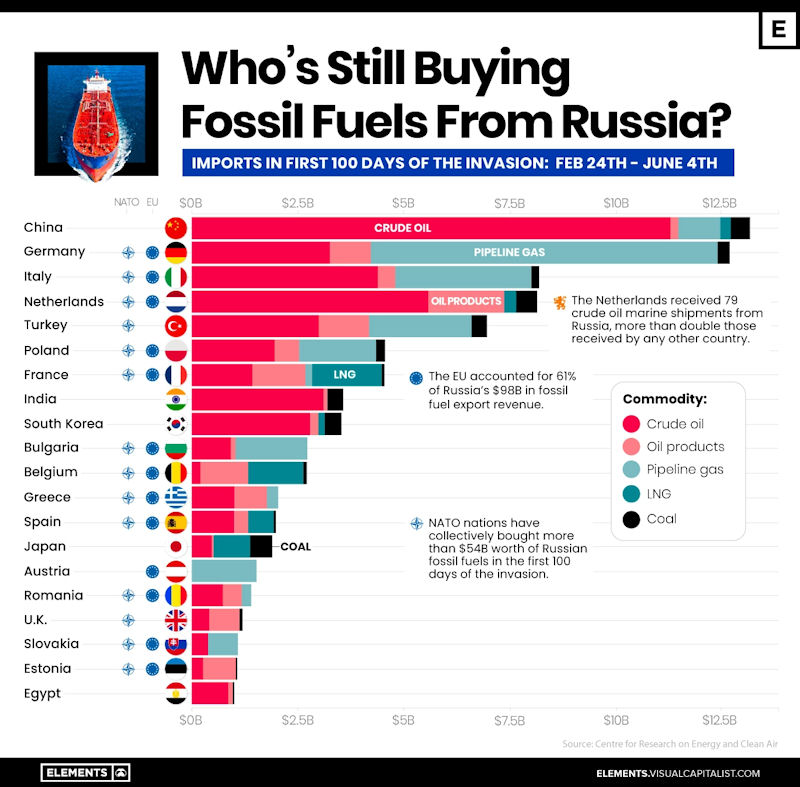
|
NEWSLETTER
|
| Join the GlobalSecurity.org mailing list |
|
|
|






